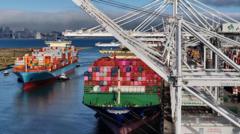Are Trump's New Tariffs Fueling the Trade War?

Understanding the Impact of Trump's Tariffs on Global Trade
In a dramatic escalation of his trade policies, former US President Donald Trump implemented sweeping tariffs that affected numerous countries worldwide. These tariffs were not merely economic measures but rather a strategic approach aimed at reshaping the global trading landscape. As the world watched, Trump declared, "IT'S MIDNIGHT!!! BILLIONS OF DOLLARS IN TARIFFS ARE NOW FLOWING INTO THE UNITED STATES OF AMERICA!" This statement marked a pivotal moment in the ongoing trade war, signaling a new era of economic isolationism and protectionism in America.
The immediate consequences of these tariffs were far-reaching, impacting both import-dependent and export-driven economies. With a particular focus on nations that had strong trade ties with China, the new tariffs were designed to protect American industries and curb the influx of foreign goods. By analyzing different aspects of these tariffs, we can better understand their implications on both domestic and international fronts.
The Rationale Behind Tariffs
Trump's tariffs aimed to address what he perceived as unfair trade practices. The rationale was rooted in the belief that the US was at a disadvantage in global trade, leading to significant trade deficits. By imposing tariffs, Trump sought to:
- Encourage domestic manufacturing and production.
- Protect American jobs from foreign competition.
- Pressure countries to negotiate better trade agreements.
These measures were part of a broader strategy to reshape the international trading system, which Trump argued had favored other countries at the expense of American workers. However, the effectiveness of such tariffs in achieving these goals remains a topic of debate among economists and trade experts.
Specific Tariff Rates Imposed
Under Trump’s administration, several countries faced significant tariff increases. For example:
- India: A 50% tariff was imposed, contingent on its cessation of purchasing Russian oil.
- Canada: The tariff rate increased from 25% to 35%, although most Canadian exports were shielded by the USMCA.
- Brazil: Exports faced a 50% tariff following accusations against its government.
- Taiwan: Subjected to a 20% tariff, with ongoing negotiations for potential adjustments.
- European Union: Agreed to a 15% tariff on goods entering the US from the bloc.
These tariffs reflected Trump's aggressive stance towards countries he believed had unfairly benefited from trade agreements in the past. However, the implications of such tariffs extended beyond the immediate financial impacts.
The Economic Ramifications
The consequences of these tariffs were multifaceted. On one hand, they aimed to bolster American industries; on the other hand, they risked igniting trade wars and retaliatory measures from affected nations. Here are some of the key economic ramifications:
- Increased Consumer Prices: Tariffs imposed on imports often lead to higher prices for consumers. As companies faced increased costs for raw materials, these expenses were frequently passed down to consumers, resulting in inflation.
- Disruption of Supply Chains: Many companies rely on global supply chains for production. Tariffs disrupted these established networks, leading to inefficiencies and potential shortages of goods.
- Retaliation from Other Countries: Many nations affected by US tariffs responded with tariffs of their own, escalating trade tensions and impacting global trade flows.
- Impact on Employment: While some sectors might have benefited from protective measures, others, particularly those reliant on imports, faced job losses and economic strain.
Negotiations and Trade Agreements
In the wake of the new tariffs, countries scrambled to negotiate agreements with the US to mitigate the impact. Major economies such as the UK, Japan, and South Korea managed to secure lower tariff rates through negotiations. This strategic diplomacy was crucial for these countries, as they sought to protect their industries and maintain favorable trade relations.
The European Union struck a framework deal with the US, accepting a 15% tariff on goods from the bloc, which marked a significant step in reducing tensions. Meanwhile, Taiwan's government indicated that the 20% tariff was temporary, emphasizing ongoing talks with Washington that could lead to adjustments.
Sector-Specific Impacts
Different sectors experienced varying degrees of impact from the tariffs. For instance, the technology sector faced significant scrutiny, especially with Trump's announcement of a 100% tariff on foreign-made semiconductors. This move aimed to encourage tech companies to invest in domestic production. Major chipmakers like TSMC, SK Hynix, and Samsung, which had already invested heavily in the US, appeared to be exempt from the new tariff, showcasing the complexities of these trade policies.
Global Reactions
International reactions to Trump's tariffs were mixed, with many countries expressing outrage over what they deemed unfair practices. For example, India condemned the increased tariff as "unfair, unjustified and unreasonable," vowing to protect its national interests. Brazil's leadership also criticized the tariffs, citing concerns over the implications for their economy.
Other nations, particularly those with close ties to the US, engaged in proactive negotiations to secure favorable terms. The trade war prompted countries to rethink their trading strategies and alliances, as they sought to navigate the changing landscape.
Long-term Implications of Tariffs
The long-term implications of Trump's tariffs on global trade remain uncertain. While they may have achieved short-term goals for the administration, the broader impact on international relations, trade dynamics, and economic stability is still unfolding. Future administrations may need to reassess these strategies, considering the evolving global economic landscape and the importance of international cooperation.
Conclusion
In conclusion, the introduction of sweeping tariffs under Trump’s administration marked a significant shift in US trade policy. While aimed at protecting American interests, these tariffs have had complex ramifications both domestically and internationally. As global trade continues to evolve, the long-term effects of these tariffs will require careful consideration and potentially a reevaluation of trade relationships and strategies. The question remains: how will future leaders approach trade in a world increasingly defined by economic interdependence?
FAQs
What are tariffs and how do they work?
Tariffs are taxes imposed on imported goods, designed to make foreign products more expensive and encourage consumers to buy domestic products. They are used as a tool to protect local industries and generate revenue for the government.
How do tariffs affect consumers?
Tariffs often lead to higher prices for goods, as companies pass on the extra costs to consumers. This can result in inflation and decreased purchasing power.
Why did Trump impose tariffs on specific countries?
Trump targeted countries that he believed engaged in unfair trade practices, aimed at protecting American jobs and industries and negotiating better trade terms.
As we reflect on the implications of these trade policies, one must consider the delicate balance between protecting domestic interests and fostering global cooperation in trade. Will future administrations continue down the path of protectionism, or will they embrace more collaborative trade practices? #TradeWar #Tariffs #GlobalEconomy
Published: 2025-08-07 04:20:11 | Category: technology



